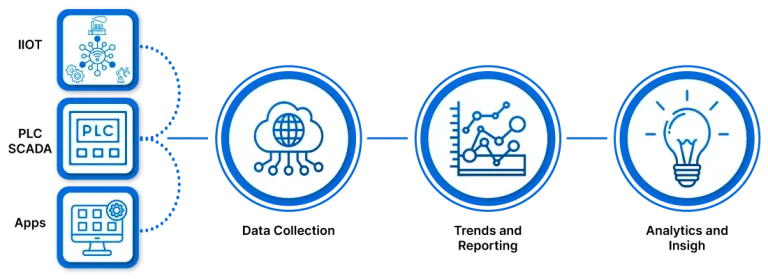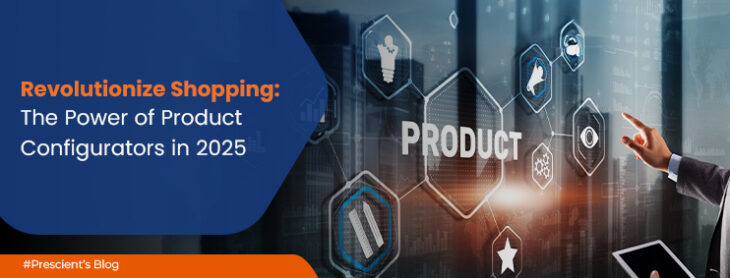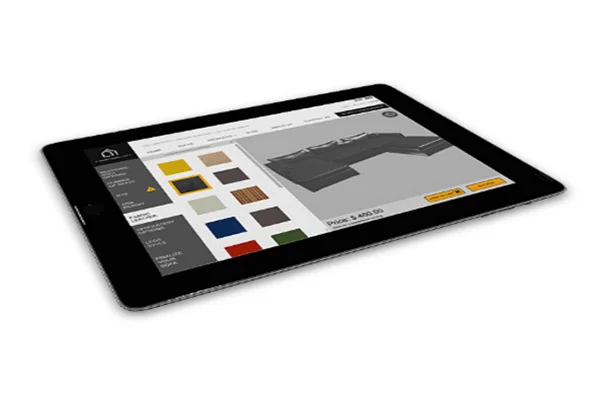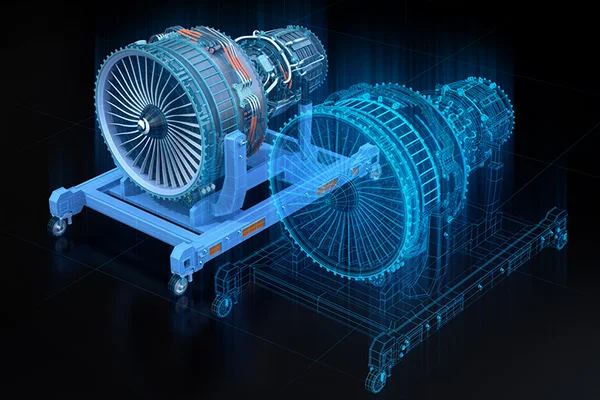IIoT Solutions
IIoT Solutions
Unlock the Power of Industrial Internet of Things (IIoT) with Prescient Technologies

Services
Key Features
Streamline Operations with Our Management Dashboard
Real-time data visualization and analytics Customizable dashboards for monitoring KPIs Alerting and notification system for proactive decision-making
Material Traceability for transparency and efficiency
End-to-end visibility and tracking of materials Prevention of counterfeit or substandard materials Compliance with regulatory requirements and quality control standards Data-driven insights for optimizing material usage and reducing waste
OEE Monitoring to maximize equipment performance
Real-time monitoring and analysis of equipment performance Calculation and visualization of OEE metrics (availability, performance, quality) Identification of bottlenecks and performance optimization opportunitie Predictive maintenance capabilities to minimize downtime and improve productivity
Energy Management for optimized energy consumption
Monitoring and optimization of energy consumption Identification of energy inefficiencies and savings opportunitie Integration with energy monitoring devices and systems Reporting and analysis of energy usage patterns and trends
Asset Management for effective asset utilization
Remote monitoring and management of industrial assets Condition monitoring and predictive maintenance Asset tracking and inventory management Real-time alerts and notifications for performance deviations
Experience the Power of IIoT
Streamline Operations with Our Management Dashboard
- Real-time data visualization and analytics
- Customizable dashboards for monitoring KPIs
- Integration with industrial systems and sensors
- Alerting and notification system for proactive decision-making
Material Traceability for transparency and efficiency
- End-to-end visibility and tracking of materials
- Prevention of counterfeit or substandard materials
- Compliance with regulatory requirements and quality control standards
- Data-driven insights for optimizing material usage and reducing waste
OEE Monitoring to maximize equipment performance
- Real-time monitoring and analysis of equipment performance
- Calculation and visualization of OEE metrics (availability, performance, quality)
- Identification of bottlenecks and performance optimization opportunities
- Predictive maintenance capabilities to minimize downtime and improve productivity
Energy Management for optimized energy consumption
- Monitoring and optimization of energy consumption
- Identification of energy inefficiencies and savings opportunities
- Integration with energy monitoring devices and systems
- Reporting and analysis of energy usage patterns and trends
Asset Management for effective asset utilization
- Remote monitoring and management of industrial assets
- Condition monitoring and predictive maintenance
- Asset tracking and inventory management
- Real-time alerts and notifications for performance deviations
Why Choose
Prescient Technologies?
-
Expertise in Engineering Process Automation
-
Successful Implementations
-
Seamless Integration and Support
-
Measurable Results

Why Choose Prescient Technologies?
Industry expertise and experience in IIoT implementations
With years of experience, our team possesses deep industry knowledge across various sectors.
Customization and scalability of solutions
Prescient Technologies is at the forefront of technology adoption. We leverage advanced tools such as machine learning and predictive analytics to deliver accurate and actionable insights.
Proactive customer support and maintenance services
At Prescient Technologies, we believe in building long-term partnerships. Our team of dedicated experts is committed to your success at every step. From the initial consultation to ongoing support,
Integration capabilities with existing systems and infrastructure
We recognize that every business is unique. Our solutions are tailored to your specific needs, challenges, and goals.
Robust security measures and compliance
Our success stories speak for themselves. Through our OEE service, we have helped numerous clients achieve significant improvements in productivity, efficiency, and quality.
Our Expertise

Featured Posts
- April 7 2025
- SRV support
Prescient Technologies Unveils New Brand Identity Reflecting Its Vision
Pune, India – 07/04/2025 – Prescient Technologies, a leading provider of advancedtechnology solutions and digital transformation services, today announced the launch ofits refreshed brand identity. The new look and messaging reflect Prescient’s renewedpurpose and evolving role as a future-forward, innovation-driven partner to globalindustries. At the heart of the new identity is a bold, modern logo with a standout orange dot on the“i”—symbolizing the spark of insight, creativity, and human-centric thinking that definesPrescient. The refreshed color palette and clean typography convey trust, clarity, andforward momentum. The refreshed identity is built on four strategic brand pillars—Integrity, Innovation,Infinity, and Impact—represented by the letter “i” in the logo. These pillars reflectPrescient’s approach to building long-term value and lasting partnerships: “These four pillars are not just values—they are the lens through whichwe deliver every solution,” said Deepti Waghmare, Director – Admin, Legal and HR. “Integrity means we stay transparent and accountable. Innovationreflects our passion for bold thinking. Infinity shows our belief inlimitless potential. And Impact is our commitment to real, measurableoutcomes.” said Deepti Waghmare, Director – Admin, Legal and HR. “Prescient has always stood for deep expertise, reliability, andforesight,” said Pravin Waghmare, CEO of Prescient Technologies.“With this new identity, we are embracing the future while staying trueto our core. It reflects how we approach every challenge, every solution, and every relationship.” “This new brand is a reflection of the evolution our customers areseeing in us,” said Ram Deshpande, VP – Sales and Marketing. “Itcommunicates who we are today—agile, future-ready, and deeply committed to our clients’ success. Our brand now mirrors the energy and ambition that drives Prescient forward.” With over two decades of technology excellence, Prescient is poised to accelerate itsglobal reach, expand digital services, and continue empowering organizations acrossmanufacturing, industrial automation, and enterprise software landscapes. Logo Decoded The Prescient logo blends simplicity with significance. Its clean, rounded typographyreflects a modern and approachable personality, while the calming blue symbolizestrust, reliability, and depth of expertise. The standout orange dot on the “i” adds a sparkof creativity—representing insight, agility, and the human touch at the heart of everysolution.The letter “i” in the logo carries deeper meaning—it embodies Prescient’s fourfoundational pillars: 1. Integrity: We uphold transparency, honesty, and accountability in everyrelationship and every solution.2. Innovation: We constantly push boundaries, embrace new ideas, and craftsolutions that shape the future.3. Infinity: Our thinking, solutions, and ambitions are limitless, reflecting our beliefin continuous evolution and boundless possibilities.4. Impact: We focus on delivering meaningful outcomes—creating real value forour clients, communities, and industries. Together, these elements form a bold, balanced, and forward-movingidentity—capturing Prescient’s unwavering spirit and purpose Media Contact: marketing@pre-scient.com
Read More- January 13 2025
- systemadmin
Ecommerce Product Configurator: Everything You Need To Know In 2025
The ecommerce industry will go through a remarkable transformation in 2025. It is driven by digital innovation and changing consumer expectations. Personalisation has become the new norm as customers increasingly seek tailored shopping experiences. At the heart of this trend are ecommerce product configurators. They are powerful tools that allow consumers to customise products in real-time. These configurators are revolutionising both B2B and B2C commerce. They are effectively closing the gap between customer preferences and business offerings. It is very clear in the fashion and automotive industries. Here, visual configurators have emerged as indispensable tools. They are increasing customer engagement and enhancing sales performance. What Is an Ecommerce Product Configurator? An e-commerce product configurator is a digital interactive tool on an ecommerce website. It enables customers to customise products before buying. Key Features Benefits The Role of Product Configurators in Ecommerce Product configurators meet the customer expectations of personalisation and interactivity. Expectations and Offerings In an era where consumers seek more control, configurators allow businesses to adapt their products to varied customer preferences. Industries Leveraging Configurators Top Features of Modern Product Configurators The latest product configurators incorporate advanced technology to provide seamless user experiences: These features make configurators valuable tools for improving customer satisfaction and operational efficiency. How Product Configurators Drive Sales Growth Visual configurators have a direct and measurable impact on sales performance: Case Studies: Most companies report a 20%–30% conversion rate increase and up to 50% growth in average order values after using configurators for engineering process automation. Overcoming Implementation Challenges While configurators have much potential, their implementation is not simple: Solutions Future Trends of Ecommerce Product Configurators in 2025 The future of ecommerce product configurators will continue changing, with these trends influencing its future: Conclusion In 2025, ecommerce product configurators will be a necessity for businesses seeking to stay competitive. These tools represent a significant leap forward in ecommerce innovation. With increasing consumer expectations, businesses have no choice but to use configurators in order to meet the interactivity and personalisation requirements that their customers are demanding. By doing so, they will increase engagement sales and lead in the fast-paced ecommerce landscape. Revolutionise Your Engineering Processes with Prescient’s Digital Thread Effectively link each aspect of your engineering activities through the Prescient Technologies Digital Thread. With this innovative technology, it enables organisations to automate workflows, eliminate inefficiencies, and increase collaboration through product lifecycles. Whether it is design iteration, real-time data integration, or traceability from concept to production, Prescient’s Digital Thread delivers unparalleled precision and agility. Join the future of engineering process automation, where innovation harmonises with efficiency. Start your journey to operational excellence. Explore Prescient’s Digital Thread today!
Read More- January 13 2025
- systemadmin
Types of Energy Management Systems
Sustainability is now a business necessity. Energy optimisation has become critical for companies across sectors. Rising energy costs and environmental regulations have propelled the adoption of Energy Management System Software. These systems reduce costs and contribute to a greener planet. They ultimately minimise energy waste. Knowing each type of energy management system is crucial to helping businesses improve efficiency and succeed. Let’s look at the applications and the value propositions these systems uphold. What Are the Four Types of Energy Management? EMS belongs to diverse use applications. These mainly include the four types described next: 1. Building Energy Management Systems (BEMS) BEMS optimises energy usage in commercial and institutional buildings. Example: A corporate office using BEMS can reduce energy consumption by 20%. It can change HVAC settings based on occupancy. 2. Industrial Energy Management Systems (IEMS) IEMS is tailored for manufacturing and production facilities. It focuses on reducing energy-intensive operations. Example: 25% of energy usage can be reduced in a factory through predictive maintenance. 3. Residential Energy Management Systems (REMS) REMS for home and housing complexes, wherein smart devices can automatically control the usage of energy Example: A homeowner can save 10% on energy by using a REMS app. The app can time the running of high-energy appliances during off-peak hours. 4. Utility Energy Management Systems (UEMS) UEMS is for utility companies that focus on the grid energy distribution level. Example: A utility company can use UEMS to control peak demand during a heatwave, avoiding power cuts while still being energy efficient. What Are Examples of Energy Management Systems? Energy Management Systems have been applied in many industries: Hypothetical Case: A logistics firm using EMS to monitor and manage warehouse energy usage will reduce its energy costs by 30%. Such is the direct business value offered by the system. How do you select the appropriate EMS? In essence, the features offered by EMS must match the business’s requirements. Some factors that dictate the selection are scalability, real-time analytics, and ease of integration. What Are the Components of Energy Management Systems? Energy Management System Software consists of three essential elements: 1. Real-Time Monitoring 2. Automated Controls 3. Energy Forecasting Value Proposition: These parts collectively reduce operational expenses, ensure environmental compliance, and support sustainability. For example, digital logbooks can record and analyse factory data online, saving thousands of dollars annually in paper resources. What is the Difference Between EMS and SCADA? EMS and SCADA are both critical components of modern industrial operations. However, they serve different purposes: Energy Management System (EMS) SCADA Synergy: EMS and SCADA integrate energy-specific information with comprehensive process control. In doing so, businesses can take full advantage of their resources in a way that leads to enhanced efficiency. How Do EMS Systems Add Value? Energy Management Systems offer quantifiable benefits: 1. Cost Efficiency 2. Improved Operational Efficiency 3. Sustainability Objectives Conclusion Energy efficiency is increasingly becoming a competitive differentiator. Hence, energy management systems are essential for businesses that want to be ahead of their competitors. Integrating digital logbooks and energy forecasting further enhances their effectiveness. Adopting an EMS pays off in the long run. They can help reduce costs and future-proof operations. Transform Your Energy Management with powerCONNECT Take charge of your energy use with powerCONNECT, the latest Energy Management System Software from Prescient Technologies. It is designed to maximise energy usage and achieve sustainability goals. Its features include real-time monitoring and predictive analytics. Both these latest technologies are available with a customisable dashboard. Power up your operations with actionable insights and unmatched efficiency. powerCONNECT is the scalable solution to stay competitive in today’s energy-conscious world. Get on the right path toward your goal of smarter and greener operations. Learn more about how Prescient Technologies can help. Schedule a demo today!
Read More1. What is IIoT?
The Industrial Internet of Things (IIoT) refers to the integration of industrial processes, machinery, and devices with Internet connectivity, allowing for real-time data collection, analysis, and communication. It enables industries to enhance operational efficiency, optimize processes, and make data-driven decisions.
2. How can IIoT solutions benefit my business?
IIoT solutions offer numerous benefits to businesses, including: 1) Improved operational efficiency and productivity 2) Enhanced asset utilization and maintenance 3) Real-time monitoring and analytics for informed decision-making 4) Increased visibility and transparency across the supply chain 5) Energy optimization and cost savings 6) Enhanced quality control and traceability 7) Proactive maintenance and reduced downtime
3. What IIoT solutions does Prescient Technologies provide?
1) Prescient Technologies offers a comprehensive suite of IIoT solutions, including: 2) Management dashboard for real-time data visualization and analytics 3) Material Traceability for end-to-end visibility and tracking of materials 4) OEE Monitoring for equipment performance optimization 5) Energy management for efficient energy consumption 6) Asset Management for remote monitoring and asset maintenance
4. Can I customize IIoT solutions to fit my specific business needs?
Yes, Prescient Technologies understands that businesses have unique requirements. Our IIoT solutions are customizable and scalable to adapt to your specific business needs, ensuring a tailored fit and maximum value.
5. How do I integrate IIoT solutions with my existing systems?
Prescient Technologies specializes in seamless integration with existing systems and infrastructure. Our expert team will work closely with you to ensure smooth integration, minimal disruption, and maximum compatibility.
6. Are IIoT solutions secure?
Prescient Technologies prioritizes data and system security. Our IIoT solutions implement robust security measures to protect against cyber threats and ensure compliance with industry standards and regulations.
7. How long does it take to implement IIoT solutions?
The implementation time for IIoT solutions can vary based on the complexity of your requirements. Prescient Technologies follows a streamlined implementation process and strives to minimize downtime during transition. The timeline will be discussed and planned during the initial consultation.
8. Do you provide training and support for IIoT solutions?
Yes, Prescient Technologies offers comprehensive training and onboarding to ensure that your team is equipped to utilize the IIoT solutions effectively. For more details contact us.
9. Can you provide examples of successful IIoT implementations?
Absolutely! Prescient Technologies has a track record of successful IIoT implementations across various industries. We have case studies and testimonials from satisfied clients that demonstrate the positive impact our solutions have had on their businesses.
10. How can I get started with Prescient Technologies' IIoT solutions?
To get started, simply reach out to us through contact@pre-scient.com. We will schedule a consultation to understand your specific requirements and propose the most suitable IIoT solutions for your business. Our team will guide you through the entire process, from solution design to implementation and ongoing support.







